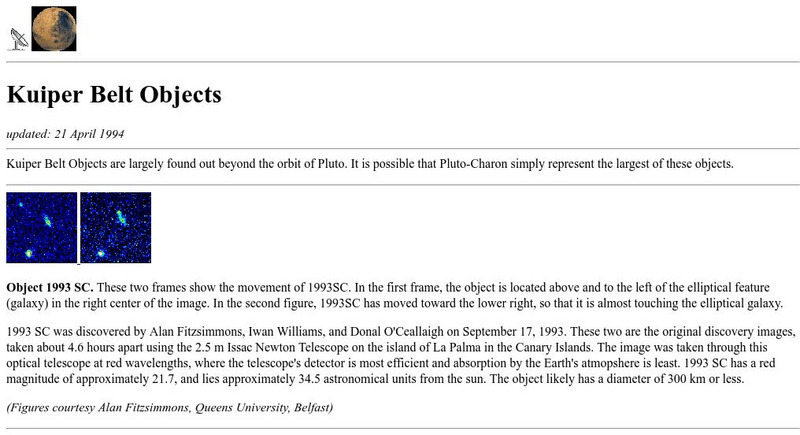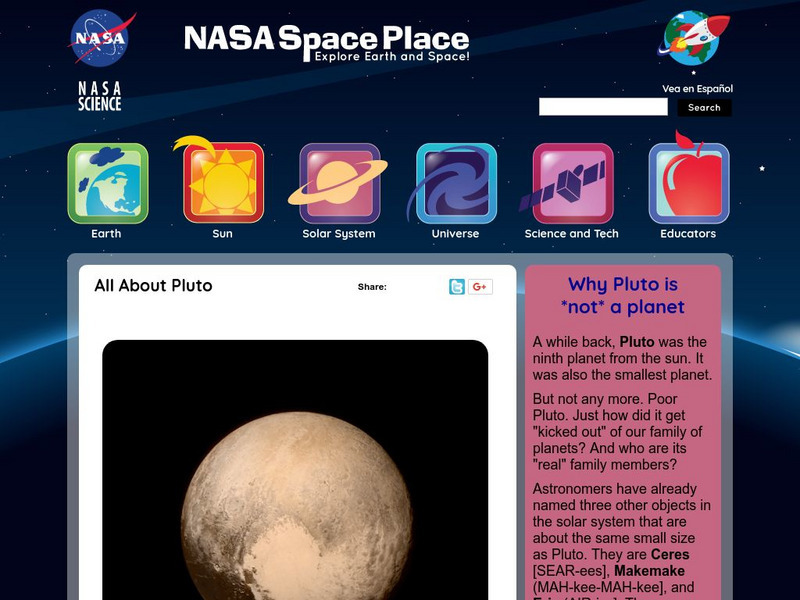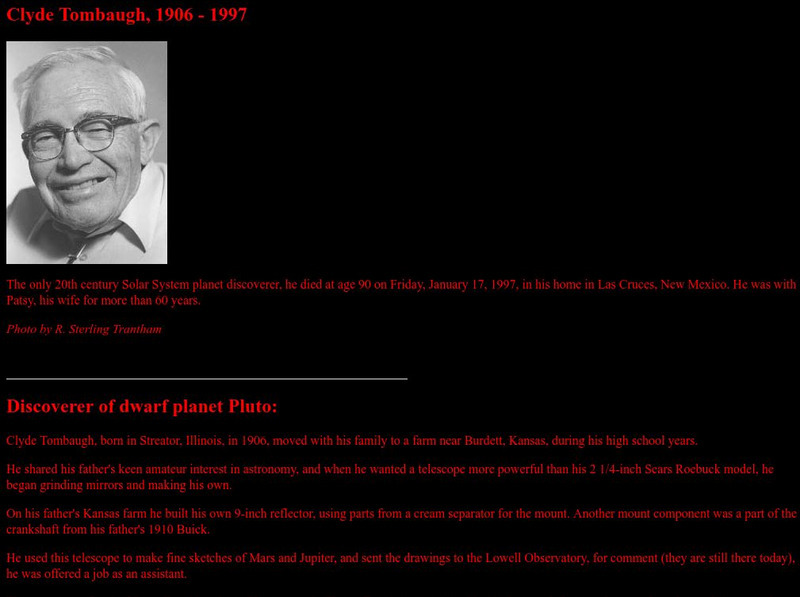Space Telescope Science Institute
Hubble Site: Solar System Images
A listing of clickable images of objects in the Solar System from the Hubble telescope that includes the following: Venus, Mars, Jupiter, Jupiter's satellites, Saturn, Saturn's rings and satellites, Uranus, Uranus' rings and satellites,...
Australian Broadcasting Corporation
Australian Broadcasting Corporation: News in Science: The Planet Formerly Known as Pluto
From ABC News in Science, this article discusses issues related to Pluto its removal from planetary status. The brief article also touches on the renaming and re-listing process of Pluto.
ClassFlow
Class Flow: What Happened to Pluto?
[Free Registration/Login Required] This flipchart was created to teach students about Pluto and the recent news of it NOT being a planet (officially). Lots of ways for students to vote on why as well as discussions about what other facts...
Johns Hopkins University
New Horizons Website
This site from the Solar System Exploration section of NASA provides an overview of the space mission to Pluto, Charon, and the fringes of our Solar System. It describes the Kuiper Belt, and the objects involved with it, provided links...
Other
Simple Science: Planetary Gallery
The innovative resource examines images of the Sun, Moon, Pluto, and all eight planets in the Solar System. Learners calculate the diameter of each object and rank the objects in order of size. The activity has an interactive online...
Arizona State University
Mars Global Surveyor: Kuiper Belt Objects
This site describes the extended belt of small bodies residing just outside the orbit of Pluto, the Kuiper Belt.
Curated OER
Science Kids: Science Images: Pluto
A photo of Pluto taken by the Hubble Space Telescope. The photo is not clear due to Pluto's small size and large distance from Earth.
Cosmos 4 kids
Cosmos4 Kids: Solar System Details: Kuiper Belt
Explore space beyond Pluto in the Kuiper Belt region of our solar system. Find out about the space bodies that exist there and what our space missions have taught us about this far away region.
Curated OER
Nasa's the Space Place: Solar System: Pluto's Orbit
An illustration showing Pluto's and the other planet's orbits around the sun.
Curated OER
Clip Art by Phillip Martin: Pluto / Hades
A clipart illustration by Phillip Martin titled "Pluto / Hades."
NASA
Nasa: The Space Place: Hail King of the Ice Dwarfs
This resource provides a nice overview of Pluto. Get information on Pluto's size, tilt, orbit and surface features. There is also a brief explanation of the "New Horizons" space probe.
NASA
Nasa's the Space Place: King of the Ice Dwarfs
An information page all about Pluto! Learn about Pluto's size, path around the sun, temperature, location, and traveling partner Charon.
NASA
Nasa: New Horizons Image Gallery
A collection of still and moving images from the New Horizon's space mission. Most of the images include descriptions and depict Pluto and its moon, Charon.
Famous Scientists
Famous Scientists: Clyde Tombaugh
Find out about Clyde Tombaugh, the scientist who discovered the dwarf planet Pluto in 1930, and also discovered a number of asteroids.
Famous Scientists
Famous Scientists: Michael E. Brown
This article discusses the life and scientific discoveries of Michael E. Brown. Learn how he is credited with downgrading Pluto from a planet to dwarf planet.
TeachEngineering
Teach Engineering: The Outer Planets
Young scholars explore the outermost planets of our solar system: Saturn, Uranus and Neptune. They also learn about characteristics of Pluto and its interactions with Neptune. Students learn a little about the history of space travel as...
Other
Observatorio Arval: Clyde Tombaugh
This is a biography page for the American astronomer and discoverer of Pluto, Clyde Tombaugh.
ClassFlow
Class Flow: Pluto Redefined
[Free Registration/Login Required] This flipchart briefly describes the new definition of planet as determined by the International Astronomical Union.
University of Wisconsin
The Why Files: Infra Red Eye Special
A description of the ways in which infra-red is used in astronomy, including an extended example describing how infra-red was used to learn about Pluto's moon, Charon. There are also links to other sites of astronomical interest.
Curated OER
Xena Awarded
This regularly updated site chronicles research, key facts, and the reasons for downgrading Pluto from a planet to dwarf planet. Recent discoveries from the New Horizon spacecraft and months of archived articles are kept here as well.
Enchanted Learning
Enchanted Learning: Zoom Astronomy: All About Space
A fantastic collection of information about the solar system. Includes information on all of the planets, the moon, the sun, asteroids, comets, meteoroids, and stars. Also find puzzles, a dictionary, quizzes, classroom activities, and...
California Institute of Technology
The Discovery of Eris, the Largest Known Dwarf Planet
Until the discovery of Eris, Pluto was known as the largest Keiper belt object. This dwarf planet has replaced Pluto in size and is accompanied by a satellite that has been given the name Dysnomia. Learn about this distant world here...
Curated OER
Nasa's the Space Place: New Horizons Mission
A photo of the New Horizons mission to visit Pluto, Charon, and the Kupier Belt.
Khan Academy
Khan Academy: How Our Solar System Formed
An article describing how the sun, planets, moons, and beyond Pluto was formed. Learn more about the beginning of our solar system.
Other popular searches
- Postcards From Pluto
- Pluto Planet
- Planets Pluto
- God Pluto
- Pluto Is a Planet
- Pluto Lesson Plans
- Dwarf Planet Pluto
- Last Day on Pluto
- Ancient Greece Pluto
- Pluto Debate
- Pluto Discovery
- Reading Comprehension Pluto
















